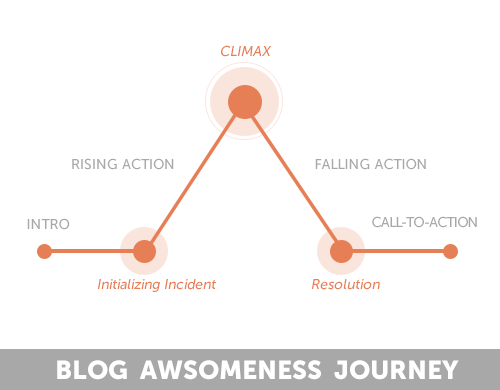Why is it so hard to write something people will actually READ? It’s one thing to share your thoughts and feelings on a topic, but it’s an entirely different thing to do it in a way that makes a difference to your readers and your business. There are plenty of copywriting tips out there that will help you boost conversions, but sometimes you need to see the process as a whole.
Here are seven steps for writing a blog post that people will actually read:
Step #1: Choose a Topic Your Audience Cares About
In the past, blogs were mostly used by teenagers to share their inner musings and bad poetry. Since then, blogging has evolved into a valuable tool that businesses use to connect with their audiences and share important information with potential customers. Unfortunately, this transition hasn’t been entirely smooth. Although business blogging has been widely adopted as a marketing practice, the people don’t always know how to select the blog topics that will best serve their business goals.
The solution is to write about topics other people care about. Don’t think about what you’d like to read – think about the problems your audience is having and how your blog content can help position your business as the solution. If you don’t know what issues your readers are facing, take the time to ask yourself a few questions. Who is your target audience is? What do they wonder about? What are their hopes and fears? What do they need help with? Write about these things and watch your readership grow.
Step #2: Write a LOT of Headlines for Every Post
Too many bloggers focus on the content of their work and wind up with barely any energy left over to write a headline. But if you want to attract readers (especially those readers who will eventually convert into customers), you have to put just as much effort into your headlines. Your headline is the first – and sometimes, the only – portion of your post that readers will see, so it pays to make it magnetic. One of the best ways to do so is to write at least 20-25 headlines and then choose the best one that will generate interest in your post.
Step #3: Focus on the Lede
The lede – which is the first few sentences of your blog post – is vital to drawing in readers and keeping them interested throughout your post. What you write in your first few sentences should engage the reader immediately and make them want to find out more. If you’re currently writing blog posts that dive immediately into important information, there’s a good chance you’re turning off readers by flooding them with too many facts, too quickly.
As with headlines, it can be helpful to write several possible introductions before selecting one. Alternatively, you may find it helpful to write your post first, and then go back and tweak the lede once you have the post fleshed out. However you approach it, just don’t fail to make this important blog post segment as enticing to readers as possible!
Step #4: Tell a Story
Everybody loves stories. There’s a reason Hollywood blockbusters seem so formulaic: they all have excitement, good guys, bad guys, conflict, and resolution. And if you’re able to incorporate these same elements into your blog posts, you’ll have a much better shot at getting readers involved long enough to finish reading your post.
Knowing that you should incorporate stories into your blog posts and actually doing it well are two different things, though. The fiction pyramid model (seen below) can help, as can setting up a problem at the beginning of a blog post and then feeding the reader bits and pieces of story throughout the post until the resolution in the conclusion. No matter how you approach it, though, using stories will help you create compelling content that will draw your readers into wanting to know more about you and your business.

Step #5: Keep the Text Well-Spaced
There’s almost nothing more intimidating or off-putting to a reader than a wall of dense text with no breaks, no spaces, and no paragraphs. You can have the greatest idea of all time, but if you present it in massive chunks of text, no one will ever know because no one will ever take the time to read it all!
Instead, make it easy to read your blog posts. Limit your paragraphs to no more than 2-4 sentences (less, if your sentences tend to be long and complex), and then invite the reader into each paragraph. When you have well-spaced paragraphs deliberately written to move readers from one to the next, you’ll dramatically increase your readership.
Step #6: Use Subheadings for Scanability
When people read a blog post, they rarely read every word. Instead, most people scan the content, grabbing some bite-sized ideas here and there before moving on. To make it easy for these readers to pick up your main points during their scans, use subheadings.
Including multiple headings divides your text into easily digestible segments, which encourages visitors to read. Subheadings also happen to be great for SEO, helping your content to rank highly in search results. When you use subheadings, you’ll not only make it more likely that your content will be read, you’ll also draw in more readers through search.
Step #7: Leave Readers Wanting More
Like a great novel, a great blog post will leave readers wanting more. Think about it: you went through a lot of trouble to get readers on to your website. The last thing you want to do is dump all the knowledge you have on to them. Not only does packing too much into a single post make it less likely readers will retain any of the information you present, it also gives them no reason to return in the future.
One way to do this is to end with a cliffhanger and invite readers back for next week’s post. You could also focus your post on a single, smaller topic and invite visitors to read related content for more information. Either way, you’ll want to wrap up your blog post with a call to action that invites readers to sign up for future updates. Getting readers on your email list will enable you to interact with them more while keeping yourself – and your blog – at the top of their minds.
With the thousands of new blogs launched every day, it’s critical to make your content stand out. By following these seven recommendations, you will improve the odds that your content will be read and that your followers will remain engaged. The results will benefit both your blog and your business.
What do you do to make sure your blog posts are read? Share your thoughts below in the comments!
Image Credits
Featured Image: Startup Stock Photos
Fiction Pyramid Image: TodayMade




